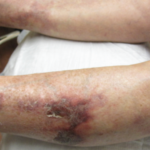In May’s “Rheuminations” column (“Make Peace with Complexity,” p. 6), we asked how you would manage gout in a patient with multiple comorbidities and complications. (See the full description at right.) We received an overwhelming number of letters recommending a range of treatment approaches. We’ve published a selection of those responses here, and we want to thank everyone who wrote in. Keep those letters coming!
—The Editors
The Patient
- Seventy-two-year-old man with heart failure;
- Taking oxygen, furosemide, and coumadin;
- Ejection fraction of 20, creatinine of 2.5, blood urea nitrogen of 60, INR near 3; and
- Fever and an infiltrate on chest X-ray that could be pneumonia, atelectasis, or pulmonary congestion.
Readers’ Treatment Strategies
Tylenol #3. Actually, I would consider a steroid taper, also, since the immunosuppression issue is probably overstated.
J. Stephen Thompson, MD, Rheumatologist
Arthritis Center of the Rockies, Loveland, Colo.
No non-steroidal anti-inflammatory drugs (NSAIDs) or colchicine. Ice works well for pain—so do narcotics, though with his respiratory status, I’m not so keen on them. I favor an intra-arterial steroid. If you’re nervous about causing a hemarthrosis, perhaps give it under ultrasound guidance. I’ve never had a problem with intra-articular bleeding in patients on warfarin with either joint injection or aspiration.
My counter-case to yours was a file I was asked to review as a medicolegal expert: A young man with congenital heart disease on warfarin went to the emergency room with one swollen, painful joint. Aspiration was not done because he is on warfarin. Instead the doctor stopped the drug, thinking he had a hemarthrosis. While off warfarin, he stroked out from a cardiac embolus. Later he had recurrent acute monoarthritis that turned out to be gout! The emergency room doctors were sued.
My literature review for that indicated that most who considered the matter felt it was safe to aspirate or inject a joint even in an anti-coagulated patient. Some suggested a smaller caliber needle as a precaution and increased pressure on the site after.
Philip Baer, MDCM, Rheumatologist
Malvern Medical Arts Centre, Toronto, Ontario
What I would do for the patient, in order of preference:
- Intra-articular steroids (as long as I felt the knee was not infected);
- Adrenocorticotropic hormone (ACTH); or
- Systemic corticosteroids if the patient is adequately covered for infection with antibiotics, but I would try a low to moderate dose (20 mg to start with rapid taper). This option is not very good, not only because of infection concerns but also because it could cause fluid retention.
Bonita Libman, MD, Associate Professor of Medicine
University of Vermont, Burlington

